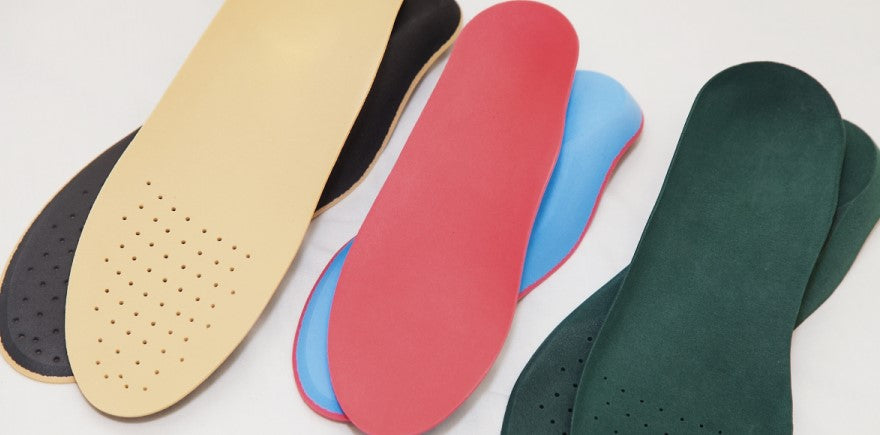
Do Cushioned Insoles Work?
When it comes to insoles, you'll find there is a lot of different advice as to whether you should go cushioned or firm. The big question is, which of that advice is good - what will make your feet feel better in the long run? Because a short-term fix just won't fix your foot issues.
The Basics ---
- Cushioned insoles don't provide long-term foot pain relief because they lack the structure to correct the causes of foot pain or prevent mechanical issues.
- When you're shopping for insoles that provide firm support, make sure you find ones that fit properly. They should mimic the contours of your feet and offer full, comfortable contact along the length of your arch.
- Firm support can take time to get used to. Start by wearing firm insoles a few hours a day and gradually increase your wear time.
- For an insole that provides firm support that helps relieve foot pain, we recommend Pace Pain Relief Insoles.
What You Need To Know ---
Do Cushioned Insoles Work?
Think about it this way. A super-soft, cushioned mattress will feel good for a night or two, but anything longer than that and you'll be left with an aching back. It's the same with insoles. Your feet need structured, firm support for long-term comfort and to correct the causes of foot pain or prevent bio-mechanical issues like overpronation.
Another thing to think about: The foam used in cushioned insoles can usually be easily compressed. So, that nice, cushy feeling you get when you first put the inserts in your shoes will be short-lived, putting you right back where you started.
Why Don't Cushioned Insoles Work?
Or perhaps the question is really "why do firm insoles work better than cushioned ones?" Let's go back to the bed analogy. Think about the arch in your lower back. Resting on a soft mattress is comfortable for your lower back at first, but in the long-term it will exacerbate issues with your spine by allowing your body to resort to old, poor postures.
A firm mattress, on the other hand, give has enough structure and support to rest your back in a neutral position. Insoles work in the same way. Cushioned insoles provide initial comfort, but ultimately they perpetuate biomechanical problems that are at the root of foot pain.
San Diego-based bio-mechanist Doug Stewart, Ph.D., maintains that support, not comfort, should be the main criteria for choosing insoles. “You want something stiff that will support the arch and be complimentary to the ligaments, fascia and tendons of the foot,” says Stewart. In fact, Stewart argues that overly squishy insoles can exacerbate injuries.
There are two main reasons cushioned insoles don’t properly support your feet.
- Soft materials are not strong enough to provide arch support. While shock-absorbing materials such as gel or foam may seem to provide arch support, they are simply filling the space below your arch with material, not actually providing a a firm foundation.
- Cushioned insoles don’t correct the biomechanical problems causing foot pain. Cushioned insoles allow your feet to move in the same manner as before. Thus they don’t address the cause of foot pain—and can’t correct it.
You may have seen heat-moldable insoles and wonder if they will work for you. While they may seem like a great, much less expensive, alternative to custom orthotics, they are are actually problematic in that the biomechanical issue you're having ends up being built into the insole. That means you won't be able to prevent, let alone correct, the issue and it will continue to cause problems.
Why Firm Insoles Work Better Than Cushioned Insoles
Firm, supportive insoles that fit properly can correct for biomechanical problems, and provide support and relief for sore, painful feet. Podiatrists recommend supportive insoles. Here’s why.
- Firm insoles help avoid hip and knee pain. When the biomechanics of your feet are off-kilter, your knees and hips suffer. Firm, supportive insoles can improve alignment and correct pronation. Good insoles do this by giving your feet structure.
- Firm insoles prevent foot ailments. Plantar fasciitis (the inflammation of the plantar fascia, a thick tissue that runs from the heel bone to the toes) can keep you on the sidelines, sitting out the things you love to do. If you’re an avid athlete or your work requires you to stand for long periods, this injury can wreak havoc on your feet. A firm, orthotic insole supports the calcaneal shelf (a bone that resembles a shelf on the inside of your heel) and controls pronation.
How Long Does It Take To Get Used To Insoles?
Just like a new, firm mattress, supportive insoles can take some breaking in. Insoles provide your feet the support they need. And they correct underlying biomechanical problems. This structure can feel different at first.
When you first get your new insoles, you'll be tempted to start wearing them all the time. For some people, it takes no time getting used to them. But for others, gradually breaking them in will be key. Having the patience to wear them for a longer period of time each day will ultimately payoff with comfortable, pain-free feet.
How Should Insoles Fit?
Most importantly, firm support that works must fit properly. The arch support of your insole should contour to the curves of your feet. Extra high arches just won't get the support they need from an insole designed for a low arch. And a person with low arches will probably find a high arch insole uncomfortable.
Make sure to get a proper fit from your insole for long-term relief. Remember, feet are not one size fits all, and neither are insoles. Find the ones that fit your feet best and provide firm support and you'll be surprised at how far you can go!
Questions? Drop us a line at hello@treadlabs.com. We're here to help.
